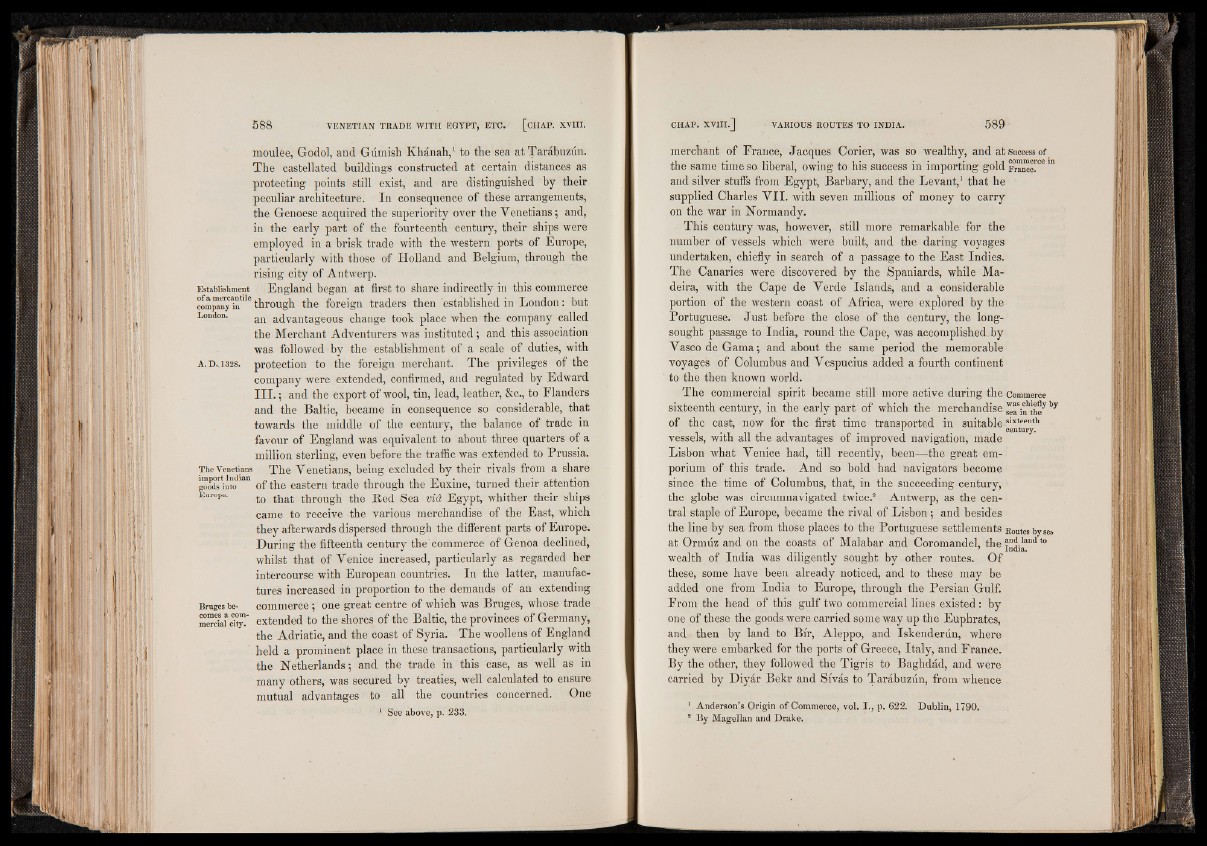
moulee, Godol, and Gumish Khanah,1 to the sea atTarabuzun.
The castellated buildings constructed at certain distances as
protecting points still exist, and are distinguished by their
peculiar architecture. In consequence of these arrangements,
the Genoese acquired the superiority over the Venetians; and,
in the early part of the fourteenth century, their ships were
employed in a brisk trade with the western ports of Europe,
particularly with those of Holland and Belgium, through the
rising city of Antwerp.
Establishment England began at first to share indirectly in this commerce
companyln*1*6 through the foreign traders then "established in London: but
London. g advantageous change took place when the company called
the Merchant Adventurers was instituted; and this association
was followed by the establishment of a scale of duties, with
A. D..1328. protection to the foreign merchant. The privileges of the
company were extended, confirmed, and regulated by Edward
I I I .; and the export of wool, tin, lead, leather, &c., to Flanders
and the Baltic, became in consequence so considerable, that
towards the middle of the century, the balance of trade in
favour of England was equivalent to about three quarters of a
million sterling, even before the traific was extended to Prussia.
The Venetians The Venetians, being excluded by their rivals from a share
goods into 'an of the eastern trade through the Euxine, turned their attention
Europe. to through the Bed Sea via Egypt, whither their ships
came to receive the various merchandise of the East, which
they afterwards dispersed through the different parts of Europe.
During the fifteenth century the'commerce of Genoa declined,
whilst that of Venice increased, particularly as regarded her
intercourse with European countries. In the latter, manufactures
increased in proportion to the demands of an extending
Bruges be- commerce; one great centre of which was Bruges, whose trade
merciaf dty!" extended to the shores of the Baltic, the provinces of Germany,
the Adriatic, and the coast of Syria. The woollens of England
held a prominent place in these transactions, particularly with
the Netherlands; and the trade in this case, as well as in
many others, was secured by treaties, well calculated to ensure
mutual advantages to all the countries concerned. One
1 See above, p. 233.
merchant of France, Jacques Corier, was so wealthy, and at Success of
the same time so liberal, owing to his success in importing gold France™ m
and silver stuffs from Egypt, Barbary, and the Levant,1 that he
supplied Charles VII. with seven millions of money to carry
on the war in Normandy.
This century was, however, still more remarkable for the
number of vessels which were built, and the. daring voyages
undertaken, chiefly in search of a passage to the East Indies.
The Canaries were discovered by the Spaniards, while Madeira,
with the Cape de Verde Islands, and a considerable
portion of the western coast of Africa, were explored by the
Portuguese. Just before the close of the century, the long-
sought passage to India, round the Cape, was accomplished by
Vasco de Gama; and about the same period the memorable
voyages of Columbus and Vespucius added a fourth continent
to the then known world.
The commercial spirit became still more active during the Commerce
sixteenth century, in the early part of which the merchandise^intiie7by
of the east, now for the first time transported in suitablesixteentl1
i i n • • century. vessels, with all the advantages of improved navigation, made
Lisbon what Venice had, till recently, been—the great emporium
of this trade. And so bold had navigators become
since the time of Columbus, that, in the succeeding century,
the globe was circumnavigated twice.2 Antwerp, as the central
staple of Europe, became the rival of Lisbon; and besides
the line by sea from those places to the Portuguese settlements Routes by se>
at Ormuz and on the coasts of Malabar and Coromandel, the S H B t0 7 India.
wealth of India was diligently sought by other routes. Of
these, some have been already noticed, and to these may be
added one from India to Europe, through the Persian Gulf.
From the head of this gulf two commercial lines existed: by
one of these the goods were carried some way up the Euphrates,
and then by land to Bir, Aleppo, and Iskenderun, where
they were embarked for the ports of Greece, Italy, and France.
By the other, they followed the Tigris to Baghdad, and were
carried by Diyar Bekr and Sivas to Tarabuzun, from whence
1 Anderson’s Origin of Commerce, vol. I., p. 622. Dublin, 1790.
1 By Magellan and Drake.